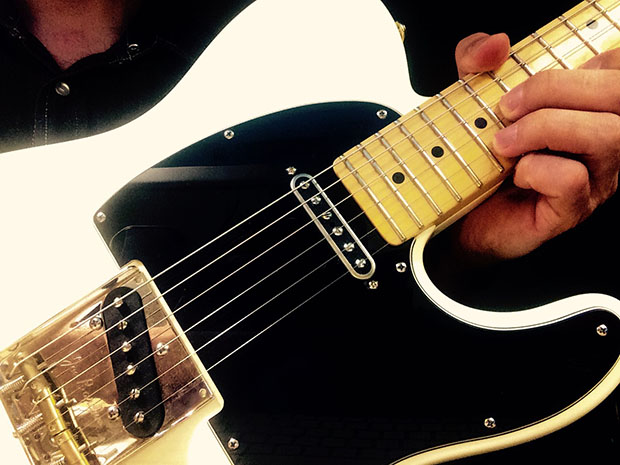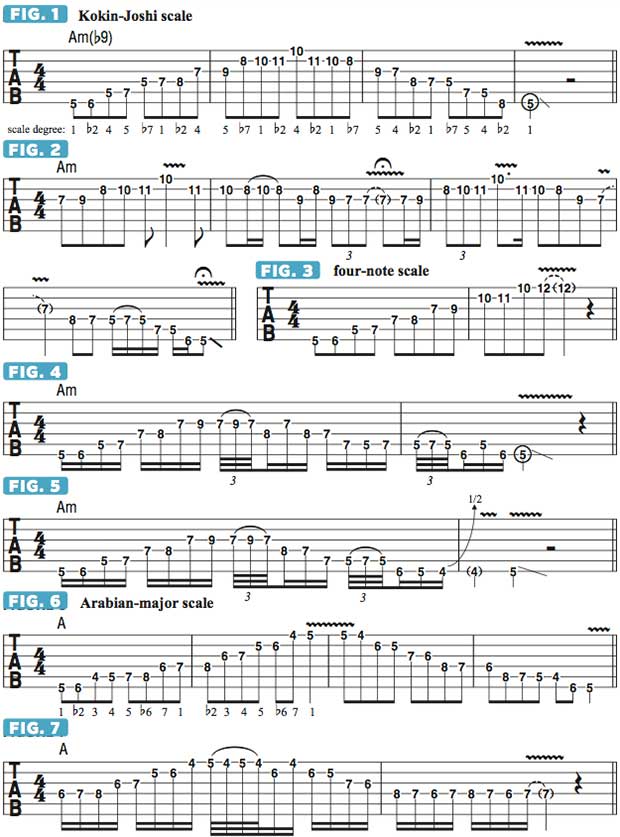Examining World-Music Scales Used in Metal Soloing, Part 1

I’d like to introduce to you a few scales that originate from different parts of the world, specifically from the eastern hemisphere, and have been incorporated into the sound of heavy metal.
We’ll begin by looking at three types of scales that work well within the context of metal and are rooted in Japanese and Arabian music. Guitarists such as Marty Friedman (Megadeth, Cacophony) and James Murphy (Death, Testament) often find different ways to inject exotic “world music” tonalities into their solos, so let’s examine a few of the scales they lean on to achieve these sounds.
First up is a Japanese scale called the Kokin-Joshi scale (see FIGURE 1). Kokin-Joshi is a minor-flavored five-tone scale, built from the intervals 1 b2 (flat two) 4 5 b7 (flat seven). You will hear this scale frequently in many of the solos Friedman played when he was in Megadeth. Practice ascending and descending the scale while mentally acknowledging its intervallic structure and the relationships between consecutive scale degrees.
This scale may be analyzed a couple of different ways: you can consider it to be a slight variation on minor pentatonic (1 b3 4 5 b7), with the b2 replacing the b3. You can also think of it as a subset of the Phrygian mode (1 b2 b3 4 5 b6 b7), with the b3 and b6 omitted. With so few notes present, the dark sound of the flatted second—Bb in the key of A—is emphasized.
FIGURE 2 is an example of how I might use the Kokin-Joshi scale in a solo, with some vibrato added to held notes and some quick hammer-ons and pull-offs used to create Japanese-flavored melodic phrases. Another cool twist is to bend up to certain notes from a half step (one fret) below), which can help further accentuate the scale’s exotic quality.
The four-note scale, shown in FIGURE 3, is another Japanese scale. It is closely associated with the Kokin-Joshi scale and is nearly identical to it. The only difference is that the b7 (G in the key of A) is omitted, resulting in the intervallic structure 1 b2 4 5. FIGURES 4 and 5 demonstrate typical ways in which I might travel up and down through the scale to create solo licks or melodic lines.
As with the Kokin-Joshi scale, I sometimes like to bend up to certain notes in this scale from a half step below, so experiment with that approach. Our last scale for this month is the Arabian-major scale, depicted in the key of A in FIGURE 6. The scale’s intervallic structure is 1 b2 3 4 5 b6 7.
The presence of the minor second with the major third, as well as the flatted sixth against the major seventh, yields a very unusual melodic flavor, one that has both dark, minor qualities and bright, major elements. Memorize this scale, then try creating some “Arabian-style” melodic lines with it, using the aforementioned phrasing and articulation devices, such as quick hammer-ons and pull- offs, as demonstrated in FIGURE 7.

Get The Pick Newsletter
All the latest guitar news, interviews, lessons, reviews, deals and more, direct to your inbox!









